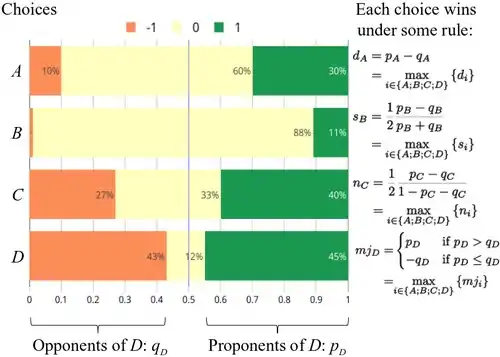Highest median voting rules
Highest median voting rules are cardinal voting rules, where the winning candidate is a candidate with the highest median rating. As these employ ratings, each voter rates the different candidates on an ordered, numerical or verbal scale.
The various highest median rules differ in their treatment of ties, i.e., the method of ranking the candidates with the same median rating.
Proponents of highest median rules argue that they provide the most faithful reflection of the voters' opinion. They note that highest median methods are among the few that can simultaneously satisfy a wide variety of voting criteria, including independence of irrelevant alternatives, monotonicity, and the Condorcet winner criterion, so long as elections do not result in ties.
Definition and notation
Let be the set of candidates, the set of voters, and an ordered finite set of ratings (e.g. the following ratings: "Very good", "Good", "Average", "Bad").
For any candidate , 's median rating is the median rating among the ratings that received from voters. For example, if there are ten voters and if candidate receives three ratings "Good", six ratings "Average", and one rating "Bad", its median rating is "Average".
If, for any candidate , , then obtained a higher median rating than all other candidates, and is elected, regardless of which highest median rule was chosen.
When different candidates share the same median rating, a tie-breaking rule is required. This tie-breaking rule characterizes the highest median rule at use.
Tie-breaking rules often make use of two additional statistics about a candidate 's ratings:[1]
- The share of proponents to , noted , which is the share of voters attributing to a rating greater than its median . In the example above, the three ratings "Good" are above 's median "Average", so .
- The share of opponents to , noted , which is the share of voters attributing to a rating lesser than its median . In the example above, this correspond to the rating "Bad", so .
Examples

- The typical judgment orders the candidates according to the largest difference between their share of proponents and opponents, i.e. according to the formula:[1] (the indices are omitted for simplicity). In the above example, and identifying "Average" with the grade , we have .
- The usual judgment is the rule said to offer the best properties,[1] but it orders the candidates according to a slightly more complex formula: ; compared to the typical judgment, this leads to a more prominent score difference in small changes of number of proponents and opponents when the median share is low, as the equation approaches 0.5 both as either or approaches 0.5 (neither can actually be 0.5, as the median lies at the halfway point by definition).
- The central judgment orders the candidates according to the highest ratio between the shares of proponents and opponents, that is to say according to the formula: (where is an arbitrarily small number that simply allows the denominator to remain positive); compared to the typical judgment, this leads to a more prominent score difference in small changes of number of proponents and opponents when the median share is high, as the equation approaches 0.5 both as either or approaches 0.5. In fact, the usual judgment is equivalent to the central judgment .
- The majority judgment considers the candidate who is closest to having a rating other than its median and breaks the tie based on that rating. This is equivalent to ordering the candidates according to their score ,[1] defined by the following formula (the symbol denotes the indicator function) : .
- The Bucklin rules are close to the highest median rules but have been developed for ranked rules. They order the candidates according to the formula: . In a ranked rule, this is equivalent to counting first choice votes first. If one candidate has a majority, that candidate wins. Otherwise the second choices are added to the first choices. If a candidate with a majority vote is found, the winner is the candidate with the most votes accumulated. Lower rankings are added as needed.[2]
- Approval voting corresponds to the degenerate case where there are only two possible ratings: approval and disapproval. In this particular case, all the tie-breaking rules are equivalent, and the Condorcet criterion is satisfied.[3]
See also
References
- Fabre, Adrien (2020). "Tie-breaking the Highest Median: Alternatives to the Majority Judgment" (PDF). Social Choice and Welfare. 56: 101–124. doi:10.1007/s00355-020-01269-9. ISSN 0176-1714. S2CID 226196615.
- Collective decisions and voting: the potential for public choice, Nicolaus Tideman, 2006, p. 204
- Brams, Steven; Fishburn, Peter (1978). "Approval Voting". American Political Science Review. 72 (3): 831–847. doi:10.2307/1955105. JSTOR 1955105. S2CID 251092061.
Further reading
- Baujard, Antoinette; Gavrel, Frédéric; Igersheim, Herrade; Laslier, Jean-François; Lebon, Isabelle (September 2017). "How voters use grade scales in evaluative voting" (PDF). European Journal of Political Economy. 55: 14–28. doi:10.1016/j.ejpoleco.2017.09.006. ISSN 0176-2680.
External links
- R package implementing different highest median rules, as well as range voting: HighestMedianRules.